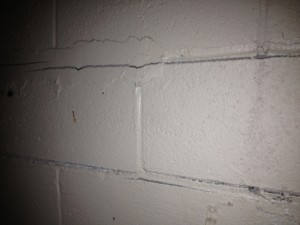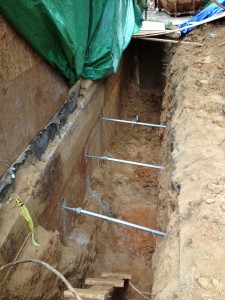It may be a hairline crack in your basement wall that worries you or it could be a large crack that was hidden behind sheet rock,
but either way you could be looking at one of the more common problems in residential foundation failure. We are often called out to see a block wall that is either bowing significantly or has a hairline crack. In either case it can be a cause for concern, but what causes horizontal cracks in basement walls?
What Causes Horizontal Cracks in Basement Walls:
- Hydrostatic Water Pressure (hī’drəstāt’ĭk) The pressure exerted by a fluid at equilibrium at a given point within the fluid, due to the force of gravity. Hydrostatic pressure increases in proportion to depth measured from the surface because of the increasing weight of fluid exerting downward force from above. cited from
-
The American Heritage® Science Dictionary
Copyright © 2002. Published by Houghton Mifflin. All rights reserved.
-
- This pressure builds up especially during rains as the grade, downspouts and ground water all work against a basement or crawl space wall. As the pressure builds it can put so much force on the exterior wall that it begins to move the wall inward.
- Heavy loading next to or above the foundation wall.
- Driveways, buildings or even vehicle traffic can put additional forces on the ground. As these forces transfer they can often move or bow a basement wall. This can often happen during the construction and back fill of a basement.
- Poor Construction
- When the wrong type of block, or hollow block is used for construction the wall is just too weak for even normal loads. Often there is a step in the block for a brick ledge that can result in a weak point as well. Hollow 8″ block are a common way houses were built in Atlanta.
The Most Common Cause of a bowing basement wall or horizontal crack in basement wall is Hydrostatic Water Pressure.
Why the horizontal crack? If the wall was built properly then the wall is “pinned” or tied to the framing at the top and “pinned” to the floor by the basement slab. This means the weakest point is the middle of the wall. As the wall bows more the crack gets bigger. Stair step cracks at either end are due in large part to the wall not being able to bow and basically it has to relieve pressure somehow.
The Repair for a bowing basement wall? Here are the most common
- Helical Tieback Anchors
- Tiebacks are a horizontal helical pier. They screw into the soil beyond the basement wall until they reach competent soil to hold the wall. Imagine a wood screw screwing into a block of wood until it is hard to turn.
- Carbon Fiber Reinforcing Strips
- Carbon Fiber Strips (FRP) act as a bonding agent to prevent the wall from bowing. They do not address the exterior forces but only hold the wall together. This method is great if the wall is poorly constructed or if the water or exterior forces have been resolved but you need a way to structurally support the wall.
- I-Beams/Soldier Beams
- An older method but one that still works. These are metal beams anchored to the concrete floor and the floor joists. Carbon Fiber have mostly replaced this method.
- Wall Anchors
- This method uses the soil to withhold the pressure of the wall. An anchor or plate is installed 10+ feet in front of the wall and another plate is tied to the wall. If the soils are good enough then the wall is strengthened enough to withhold the pressure.
- Timber Framing
- A timber wall is built in front of the bowing block wall. This acts as reinforcement much like soldier beams would.
Depending on the severity of the failure would depend on the method of repair. Call 404-662-2454 or email info@foundation-worx.com for a free evaluation.




